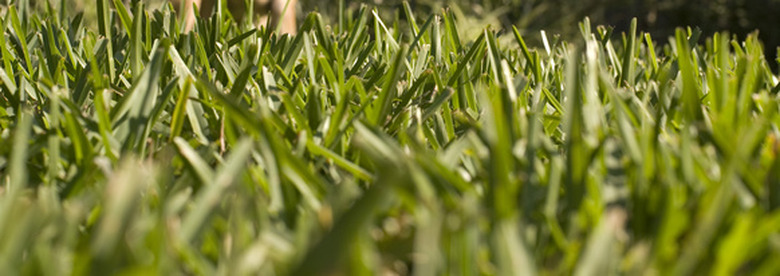How To Make St. Augustine Grass Greener And Fuller
Things Needed
-
Fertilizer
-
Adjustable height lawn mower
-
Foliar iron supplement spray
St. Augustine grass thrives in warm and temperate climates with ample water and regular feeding. Keeping the turf green and lush requires weekly maintenance to optimize the growing conditions and encourage vigorous growth. When underwatered, overmowed or grown in deep shade, St. Augustine grass can become thin and weak.
Step 1
Provide St. Augustine grass with full sun, lightly filtered shade or partial daily shade exposure. Prune away or thin overhead branches and plants to increase sunlight to the area.
Step 2
Water regularly and deeply to keep the thatch and soil just below it moist at all times, but not consistently wet. Apply a minimum of 1 inch of water per week for average climates and soil conditions. Apply more water, more frequently in hot or dry climates or when growing the grass over sandy, fast-draining soil. Water once or twice per week, drenching the soil 4 to 6 inches deep to keep the root zone well-hydrated.
Step 3
Mow St. Augustine grass at the proper height for the species to maintain the optimal green look and lush feel. Keep the grass between 1 and 3 inches high; the longer the length, the greener the grass will appear and the softer it will be underfoot. Keep the grass at 3 inches high when growing in shady conditions.
Step 4
Fertilize once a month from spring through fall with a complete lawn fertilizer. Apply over the lawn evenly according to the manufacturer's recommended rate for your soil content. Do not exceed 1 lb. of actual nitrogen for every 1,000 sq. ft. of lawn turf each month, or excess thatch and weak growth can result. Water the fertilizer well to wash the grains down to the thatch and into the root zone. Drench the soil at least 4 inches down after feeding.
Step 5
Spray yellowing St. Augustine grass growing over alkaline or iron-depleted soil with an iron sulfate or chelate foliar supplement to correct the nutrient deficiency and boost the green color in the blades. Apply according to the product label directions. Repeat as needed and recommended throughout the growing season.
Tip
When St. Augustine grass is grown in consistent deep shade with no sun, the growth will be weak and the soil coverage thin.
